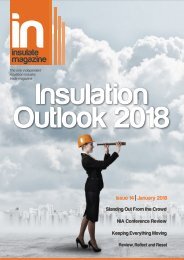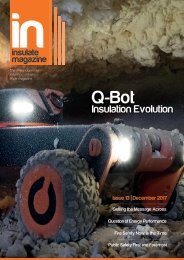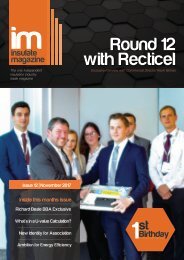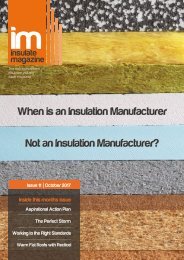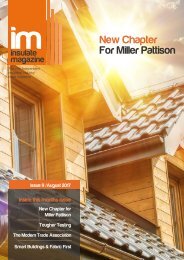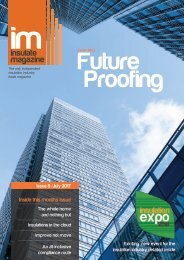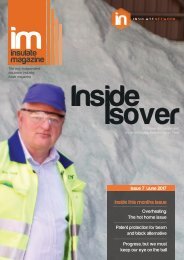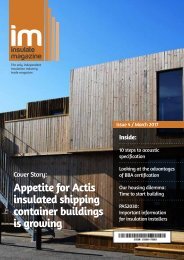Insulate Magazine Issue 17
Create successful ePaper yourself
Turn your PDF publications into a flip-book with our unique Google optimized e-Paper software.
The only independent insulation industry trade magazine<br />
<strong>Insulate</strong> Insight<br />
New forms of Insulation<br />
Something to Reflect on<br />
Marin Oxley Charts the rise of reflective insulation<br />
A<br />
fter running 26.2 miles and receiving your<br />
well-earned finisher’s medal, you usually<br />
receive a goody bag after completing<br />
your marathon. Along with the T-shirt, snack<br />
bar and muscle-relieving pain gel, you will find<br />
a shiny, highly reflective space blanket. This<br />
helps to keep you warm after you have stopped<br />
running – so why not use the sametechnology<br />
to keep your house warm as well?<br />
Testing the Performance<br />
When the first reflective insulation products hit the<br />
shelves of builder’s merchants many years ago, there<br />
was limited certified testing, so some of their original<br />
performance claims might have been a little optimistic.<br />
Testing houses in both the UK and Europe also<br />
achieved varying results after analysing the products<br />
in the same way as they normally would traditional<br />
insulants.<br />
So while the test houses and manufacturers agreed<br />
on a standard testing methodology for thermal<br />
performance, a process which took a few years,<br />
some companies opted for in-situ evaluation.<br />
It soon became apparent that it was extremely difficult<br />
to build ‘standard houses’ repeatedly and ensure<br />
that thermal performance and weathering conditions<br />
remained absolutely identical, so as to evaluate the<br />
true performance of these new reflective insulants<br />
with 100% accuracy. This caused market confusion<br />
and ultimately led to many architects, specifiers and<br />
contractors not selecting reflective insulation for their<br />
projects.<br />
Thermal Performance Standard<br />
After several rounds of evaluation with some of the<br />
best testing houses for insulation’s thermal performance,<br />
in 2012 Europe agreed on a standard thermal<br />
Europe is currently<br />
developing a harmonised<br />
European Product<br />
Standard for reflective<br />
insulation which is due to<br />
be published shortly. Once officially<br />
issued, manufacturers will then be able<br />
to CE-mark their product to encourage<br />
increased sales across Europe.<br />
performance testing standard, BS EN 16012: 2012<br />
+A1: 2015 Thermal insulation for buildings – Reflective<br />
insulation products – Determination of the declared<br />
thermal performance. (http://bit.ly/2bramb2).<br />
There was now a defined methodology for direct<br />
thermal comparison of reflective insulants. This, together<br />
with the emergence of the first reflective insulation<br />
certificates from the British Board of Agrément<br />
(BBA) over <strong>17</strong> years ago, increased the credibility of<br />
the industry and provided consumers with the reassurance<br />
they required, and sales started to increase<br />
significantly during this period.<br />
Radiation of Heat<br />
All insulation products work by reducing heat flow, in<br />
one or more of three ways: conduction, convection or<br />
radiation. Heat always flows from the hot side to the<br />
cold side.<br />
Reflective insulation’s key feature is, of course, to limit<br />
heat flow by radiation. The radiated energy is invisible<br />
and causes no rise in temperature until it hits a<br />
surface, where it is absorbed and causes the object<br />
to get warmer. For instance, radiative energy from the<br />
sun will pass through double-glazing and once it hits<br />
an object inside the conservatory it starts to heat it<br />
up.<br />
6<br />
www.insulatenetwork.com






